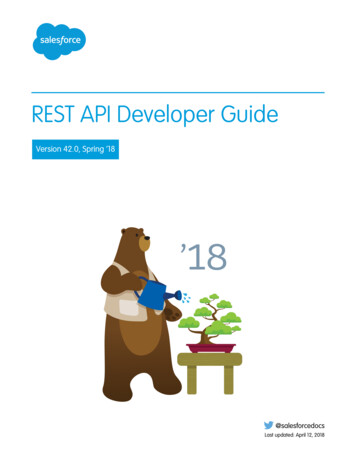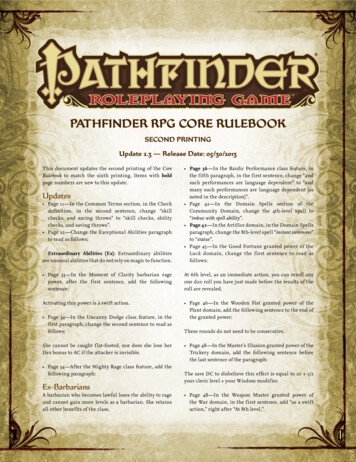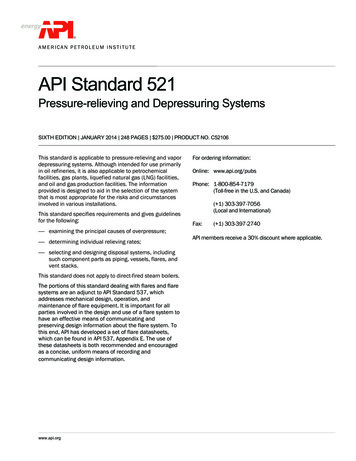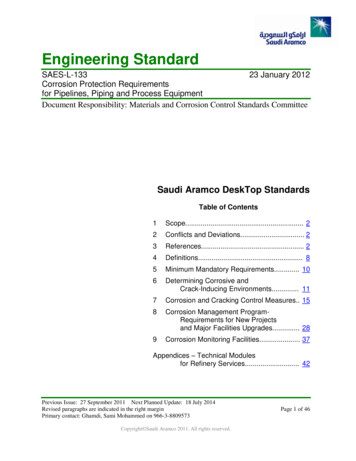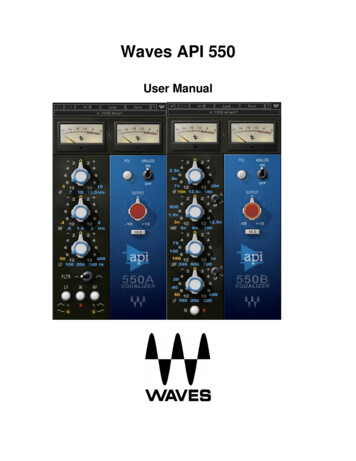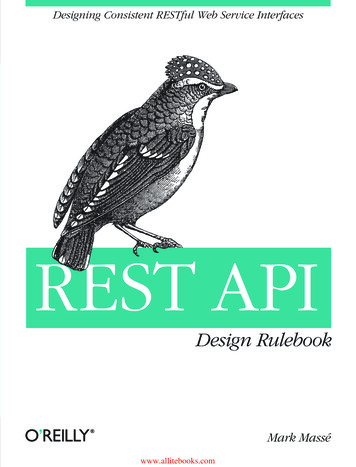
Transcription
www.allitebooks.com
www.allitebooks.com
Download from Wow! eBook www.wowebook.com REST API Design RulebookMark MasséBeijing Cambridge Farnham Köln Sebastopol Tokyowww.allitebooks.com
REST API Design Rulebookby Mark MasséCopyright 2012 Mark Massé. All rights reserved.Printed in the United States of America.Published by O’Reilly Media, Inc., 1005 Gravenstein Highway North, Sebastopol, CA 95472.O’Reilly books may be purchased for educational, business, or sales promotional use. Online editionsare also available for most titles (http://my.safaribooksonline.com). For more information, contact ourcorporate/institutional sales department: (800) 998-9938 or corporate@oreilly.com.Editor: Simon St. LaurentProduction Editor: Kristen BorgProofreader: O’Reilly Production ServicesCover Designer: Karen MontgomeryInterior Designer: David FutatoIllustrator: Robert RomanoRevision History for the First Edition:2011-10-17First releaseSee http://oreilly.com/catalog/errata.csp?isbn 9781449310509 for release details.Nutshell Handbook, the Nutshell Handbook logo, and the O’Reilly logo are registered trademarks ofO’Reilly Media, Inc. REST API Design Rulebook, the image of a crested shriketit, and related trade dressare trademarks of O’Reilly Media, Inc.Many of the designations used by manufacturers and sellers to distinguish their products are claimed astrademarks. Where those designations appear in this book, and O’Reilly Media, Inc., was aware of atrademark claim, the designations have been printed in caps or initial caps.While every precaution has been taken in the preparation of this book, the publisher and authors assumeno responsibility for errors or omissions, or for damages resulting from the use of the information contained herein.ISBN: m
For my amazing dad, Robert P. Massé, who is theauthor of books on subjects ranging from the“Nature of Physical Fields and Forces” to amysterious “Ghost Nose” that rides a big wheel.Dad, thanks for giving me my very first O’Reillybook and for teaching me to never stop learning.www.allitebooks.com
www.allitebooks.com
Table of ContentsPreface . . . . . . . . . . . . . . . . . . . . . . . . . . . . . . . . . . . . . . . . . . . . . . . . . . . . . . . . . . . . . . . . . . . . . ix1. Introduction . . . . . . . . . . . . . . . . . . . . . . . . . . . . . . . . . . . . . . . . . . . . . . . . . . . . . . . . . . . 1Hello World Wide WebWeb ArchitectureClient–ServerUniform InterfaceLayered SystemCacheStatelessCode-On-DemandWeb StandardsRESTREST APIsREST API DesignRulesWRMLRecap1233444455566772. Identifier Design with URIs . . . . . . . . . . . . . . . . . . . . . . . . . . . . . . . . . . . . . . . . . . . . . . 11URIsURI FormatRule: Forward slash separator (/) must be used to indicate a hierarchicalrelationshipRule: A trailing forward slash (/) should not be included in URIsRule: Hyphens (-) should be used to improve the readability of URIsRule: Underscores ( ) should not be used in URIsRule: Lowercase letters should be preferred in URI pathsRule: File extensions should not be included in URIsURI Authority DesignRule: Consistent subdomain names should be used for your APIs11111212121213131414iiiwww.allitebooks.com
Download from Wow! eBook www.wowebook.com Rule: Consistent subdomain names should be used for your client developer portalResource ModelingResource ArchetypesDocumentCollectionStoreControllerURI Path DesignRule: A singular noun should be used for document namesRule: A plural noun should be used for collection namesRule: A plural noun should be used for store namesRule: A verb or verb phrase should be used for controller namesRule: Variable path segments may be substituted with identity-basedvaluesRule: CRUD function names should not be used in URIsURI Query DesignRule: The query component of a URI may be used to filter collectionsor storesRule: The query component of a URI should be used to paginate collection or store resultsRecap1414151515161616171717171818191920203. Interaction Design with HTTP . . . . . . . . . . . . . . . . . . . . . . . . . . . . . . . . . . . . . . . . . . . . 23HTTP/1.1Request MethodsRule: GET and POST must not be used to tunnel other request methodsRule: GET must be used to retrieve a representation of a resourceRule: HEAD should be used to retrieve response headersRule: PUT must be used to both insert and update a stored resourceRule: PUT must be used to update mutable resourcesRule: POST must be used to create a new resource in a collectionRule: POST must be used to execute controllersRule: DELETE must be used to remove a resource from its parentRule: OPTIONS should be used to retrieve metadata that describes aresource’s available interactionsResponse Status CodesRule: 200 (“OK”) should be used to indicate nonspecific successRule: 200 (“OK”) must not be used to communicate errors in the response bodyRule: 201 (“Created”) must be used to indicate successful resource creationiv Table of 8282828
Rule: 202 (“Accepted”) must be used to indicate successful start of anasynchronous actionRule: 204 (“No Content”) should be used when the response body isintentionally emptyRule: 301 (“Moved Permanently”) should be used to relocate resourcesRule: 302 (“Found”) should not be usedRule: 303 (“See Other”) should be used to refer the client to a differentURIRule: 304 (“Not Modified”) should be used to preserve bandwidthRule: 307 (“Temporary Redirect”) should be used to tell clients to resubmit the request to another URIRule: 400 (“Bad Request”) may be used to indicate nonspecific failureRule: 401 (“Unauthorized”) must be used when there is a problem withthe client’s credentialsRule: 403 (“Forbidden”) should be used to forbid access regardless ofauthorization stateRule: 404 (“Not Found”) must be used when a client’s URI cannot bemapped to a resourceRule: 405 (“Method Not Allowed”) must be used when the HTTPmethod is not supportedRule: 406 (“Not Acceptable”) must be used when the requested mediatype cannot be servedRule: 409 (“Conflict”) should be used to indicate a violation of resourcestateRule: 412 (“Precondition Failed”) should be used to support conditionaloperationsRule: 415 (“Unsupported Media Type”) must be used when the mediatype of a request’s payload cannot be processedRule: 500 (“Internal Server Error”) should be used to indicate API 334. Metadata Design . . . . . . . . . . . . . . . . . . . . . . . . . . . . . . . . . . . . . . . . . . . . . . . . . . . . . . 35HTTP HeadersRule: Content-Type must be usedRule: Content-Length should be usedRule: Last-Modified should be used in responsesRule: ETag should be used in responsesRule: Stores must support conditional PUT requestsRule: Location must be used to specify the URI of a newly created resourceRule: Cache-Control, Expires, and Date response headers should beused to encourage caching3535353536363737Table of Contents vwww.allitebooks.com
Rule: Cache-Control, Expires, and Pragma response headers may beused to discourage cachingRule: Caching should be encouragedRule: Expiration caching headers should be used with 200 (“OK”) responsesRule: Expiration caching headers may optionally be used with 3xx and4xx responsesRule: Custom HTTP headers must not be used to change the behaviorof HTTP methodsMedia TypesMedia Type SyntaxRegistered Media TypesVendor-Specific Media TypesMedia Type DesignRule: Application-specific media types should be usedRule: Media type negotiation should be supported when multiple representations are availableRule: Media type selection using a query parameter may be supportedRecap38383838383939394041414344445. Representation Design . . . . . . . . . . . . . . . . . . . . . . . . . . . . . . . . . . . . . . . . . . . . . . . . . . 47Message Body FormatRule: JSON should be supported for resource representationRule: JSON must be well-formedRule: XML and other formats may optionally be used for resource representationRule: Additional envelopes must not be createdHypermedia RepresentationRule: A consistent form should be used to represent linksRule: A consistent form should be used to represent link relationsRule: A consistent form should be used to advertise linksRule: A self link should be included in response message body representationsRule: Minimize the number of advertised “entry point” API URIsRule: Links should be used to advertise a resource’s available actions ina state-sensitive mannerMedia Type RepresentationRule: A consistent form should be used to represent media type formatsRule: A consistent form should be used to represent media type schemasError RepresentationRule: A consistent form should be used to represent errorsRule: A consistent form should be used to represent error responsesvi Table of 5565659686869
Rule: Consistent error types should be used for common error conditionsRecap70706. Client Concerns . . . . . . . . . . . . . . . . . . . . . . . . . . . . . . . . . . . . . . . . . . . . . . . . . . . . . . . . 71IntroductionVersioningRule: New URIs should be used to introduce new conceptsRule: Schemas should be used to manage representational form versionsRule: Entity tags should be used to manage representational state versionsSecurityRule: OAuth may be used to protect resourcesRule: API management solutions may be used to protect resourcesResponse Representation CompositionRule: The query component of a URI should be used to support partialresponsesRule: The query component of a URI should be used to embed linkedresourcesProcessing HypermediaJavaScript ClientsRule: JSONP should be supported to provide multi-origin read accessfrom JavaScriptRule: CORS should be supported to provide multi-origin read/write access from JavaScriptRecap717171727272727373747678798082837. Final Thoughts . . . . . . . . . . . . . . . . . . . . . . . . . . . . . . . . . . . . . . . . . . . . . . . . . . . . . . . . 85State of the ArtUniform ImplementationPrinciple: REST API designs differ more than necessaryPrinciple: A REST API should be designed, not codedPrinciple: Programmers and their organizations benefit from consistencyPrinciple: A REST API should be created using a GUI toolRecap85868687888991Appendix: My First REST API . . . . . . . . . . . . . . . . . . . . . . . . . . . . . . . . . . . . . . . . . . . . . . . . . . . 93Table of Contents vii
PrefaceGreetings Program!Representational State Transfer (REST) is a technical description of how the WorldWide Web* works. Specifically, REST tells us how the Web achieves its great scale. Ifthe Web can be said to have an “operating system,” its architectural style is REST.A REST Application Programming Interface (REST API) is a type of web server thatenables a client, either user-operated or automated, to access resources that model asystem’s data and functions.This book is a REST API designer’s style guide and reference. It proposes a set ofrules that you can leverage to design and develop REST APIs.Conventions Used in This BookThe following typographical conventions are used in this book:ItalicIndicates new terms, URLs, email addresses, filenames, and file extensions.Constant widthUsed for program listings, as well as within paragraphs to refer to program elementssuch as variable or function names, databases, data types, environment variables,statements, and keywords.Constant width boldShows commands or other text that should be typed literally by the user.Constant width italicShows text that should be replaced with user-supplied values or by values determined by context.* The “World Wide Web” is more commonly known as “the Web,” which is how this book refers to it.ix
This icon signifies a tip, suggestion, or general note.This icon indicates a warning or caution.Using Code ExamplesThis book is here to help you get your job done. In general, you may use the code inthis book in your programs and documentation. You do not need to contact us forpermission unless you’re reproducing a significant portion of the code. For example,writing a program that uses several chunks of code from this book does not requirepermission. Selling or distributing a CD-ROM of examples from O’Reilly books doesrequire permission. Answering a question by citing this book and quoting examplecode does not require permission. Incorporating a significant amount of example codefrom this book into your product’s documentation does require permission.We appreciate, but do not require, attribution. An attribution usually includes the title,author, publisher, and ISBN. For example: “REST API Design Rulebook by Mark Massé(O’Reilly). Copyright 2012 Mark Massé, 978-1-449-31050-9.”If you feel your use of code examples falls outside fair use or the permission given above,feel free to contact us at permissions@oreilly.com.Safari Books OnlineSafari Books Online is an on-demand digital library that lets you easilysearch over 7,500 technology and creative reference books and videos tofind the answers you need quickly.With a subscription, you can read any page and watch any video from our library online.Read books on your cell phone and mobile devices. Access new titles before they areavailable for print, and get exclusive access to manuscripts in development and postfeedback for the authors. Copy and paste code samples, organize your favorites, download chapters, bookmark key sections, create notes, print out pages, and benefit fromtons of other time-saving features.O’Reilly Media has uploaded this book to the Safari Books Online service. To have fulldigital access to this book and others on similar topics from O’Reilly and other publishers, sign up for free at http://my.safaribooksonline.com.x Preface
How to Contact UsPlease address comments and questions concerning this book to the publisher:O’Reilly Media, Inc.1005 Gravenstein Highway NorthSebastopol, CA 95472800-998-9938 (in the United States or Canada)707-829-0515 (international or local)707-829-0104 (fax)We have a web page for this book, where we list errata, examples, and any additionalinformation. You can access this page at:http://oreilly.com/catalog/0636920021575To comment or ask technical questions about this book, send email to:bookquestions@oreilly.comFor more information about our books, courses, conferences, and news, see our websiteat http://www.oreilly.com.Find us on Facebook: http://facebook.com/oreillyFollow us on Twitter: http://twitter.com/oreillymediaWatch us on YouTube: I could not have written this book without the help of the folks mentioned here.Tim Berners-LeeAs a member of the World Wide Web generation, I have spent my entire career as asoftware engineer working in, and adding to, the Web. I am eternally grateful to TimBerners-Lee for his “WorldWideWeb” project. A triumph; huge success.Roy FieldingRoy Fielding’s pioneering Ph.D. dissertation was the primary inspiration for this book.If you want to learn all about REST from its original author, I highly recommend thatyou read Fielding’s dissertation.†† Fielding, Roy Thomas. Architectural Styles and the Design of Network-based Software Architectures, Doctoraldissertation, University of California, Irvine, 2000 (http://www.ics.uci.edu/ fielding/pubs/dissertation/top.htm).Preface xi
Download from Wow! eBook www.wowebook.com Leonard RichardsonIn an effort to distinguish between RESTful and other Web API designs, Leonard Richardson proposed‡ what has come to be known as the “Richardson Maturity Model.”In his model, Richardson outlined three distinct levels of REST API maturity:1. URI2. HTTP3. HypermediaEach level corresponds with an aspect of the Web’s uniform interface that an API mustembrace in order to be considered RESTful. The maturity model’s level-based classification system has helped me evaluate and concisely communicate the RESTfulnessof many Web API designs.§O’Reilly Media, Inc.I have been a fan of O’Reilly’s books for as long as I’ve been programming. Workingon this project with O’Reilly’s Simon St. Laurent has been an incredible experience andan honest to goodness dream come true for me. I am greatly honored to have been giventhis opportunity and I thank Simon and everyone at O’Reilly Media for their supportand encouragement.Additionally, this book would not exist without these foundational books, also published by O’Reilly: Richardson, Leonard, and Sam Ruby. RESTful Web Services. Sebastopol: O’ReillyMedia, Inc., 2007. Allamaraju, Subbu. RESTful Web Services Cookbook. Sebastopol: O’Reilly Media,Inc., 2010. Webber, Jim, Savas Parastatidis, and Ian Robinson. REST in Practice: Hypermediaand Systems Architecture. Sebastopol: O’Reilly Media, Inc., 2010.Technical ReviewersI am indebted to this book’s technical reviewers. Each one took the time to read throughrough drafts of this book and provided insightful feedback that improved the end result.Many thanks to: Mike Amundsen, Ryan Christianson, Jason Guenther, Brian Jackson,Greg Katz, Will Merydith, Leonard Richardson, Daniel Roop, Nigel Simpson, and Cameron Stevens.‡ ct3.html§ Leonard Richardson also co-authored the milestone book, RESTful Web Services (O’Reilly) which reallyhelped move REST forward.xii Preface
ColleaguesWill Wiess, Scott Thompson, Kelley Faraone, Eric Freeman, and Nick Choat supportedmy learning and teaching efforts over the past few years. Thank you all.The REST CommunityFrom a career perspective, this is an exciting time to be both working with and usingthe Web! This book was influenced by anyone who has ever posted a scrap of information about REST on the Web; or at least to those that search engines could find.Over the years, I have pored over too many “REST API” articles and examples to count.I know that each one helped shape my mental model of the best practices of REST APIdesign.Stuart RackhamThanks also to Stuart Rackham for AsciiDoc.‖ It is an awesome tool that made formatting this book a breeze.PersonalMy brother Mike Massé is a Web-based rock star. His music provided the soundtrackfor all my writing sessions. Mike’s talents and passions have been a lifelong inspirationto me.Thanks to my family (daughter, mom, dad, and sisters) for their patience and supportwhile I was off the grid working on this book.Finally, I thank Shawna Stine, for being the book’s first reviewer and biggest fan.‖ http://www.methods.co.nz/asciidocPreface xiii
CHAPTER 1IntroductionHello World Wide WebThe Web started in the “data acquisition and control” group at the European Organization for Nuclear Research (CERN), in Geneva, Switzerland. It began with a computerprogrammer who had a clever idea for a new software project.In December of 1990, to facilitate the sharing of knowledge, Tim Berners-Lee starteda non-profit software project that he called “WorldWideWeb.”* After working diligently on his project for about a year, Berners-Lee had invented and implemented: The Uniform Resource Identifier (URI), a syntax that assigns each web documenta unique address The HyperText Transfer Protocol† (HTTP), a message-based language that computers could use to communicate over the Internet. The HyperText Mark-up Language (HTML), to represent informative documentsthat contain links to related documents. The first web server.‡ The first web browser, which Berners-Lee also named “WorldWideWeb” and laterrenamed “Nexus” to avoid confusion with the Web itself. The first WYSIWYG§ HTML editor, which was built right into the browser.* The WorldWideWeb project was later renamed the “World Wide Web,” with added spaces.† Berners-Lee, Tim. The Original HTTP as defined in 1991, W3C, 1991 ml).‡ The first web server is still up and running at http://info.cern.ch.§ WYSIWYG is an acronym for What You See Is What You Get.1
On August 6, 1991, on the Web’s first page, Berners-Lee wrote,The WorldWideWeb (W3) is a wide-area hypermedia information retrieval initiativeaiming to give universal access to a large universe of documents.‖From that moment, the Web began to grow, at times exponentially. Within five years,the number of web users skyrocketed to 40 million. At one point, the number wasdoubling every two months. The “universe of documents” that Berners-Lee had described was indeed expanding.In fact, the Web was growing too large, too fast, and it was heading toward collapse.The Web’s traffic was outgrowing the capacity of the Internet infrastructure. Additionally, the Web’s core protocols were not uniformly implemented and they lackedsupport for caches and other stabilizing intermediaries. With such rapid expansion, itwas unclear if the Web would scale to meet the increasing demand.Web ArchitectureIn late 1993, Roy Fielding, co-founder of the Apache HTTP Server Project,# becameconcerned by the Web’s scalability problem.Upon analysis, Fielding recognized that the Web’s scalability was governed by a set ofkey constraints. He and others set out to improve the Web’s implementation with apragmatic approach: uniformly satisfy all of the constraints so that the Web couldcontinue to expand.The constraints, which Fielding grouped into six categories and collectively referred toas the Web’s architectural style, are:1.2.3.4.5.6.Client-serverUniform interfaceLayered systemCacheStatelessCode-on-demandEach constraint category is summarized in the following subsections.‖ Berners-Lee, Tim. World Wide Web, W3C, 1991 g.2 Chapter 1: Introductionwww.allitebooks.com
Client–ServerThe separation of concerns is the core theme of the Web’s client-server constraints.The Web is a client-server based system, in which clients and servers have distinct partsto play. They may be implemented and deployed independently, using any languageor technology, so long as they conform to the Web’s uniform interface.Uniform InterfaceThe interactions between the Web’s components—meaning its clients, servers, andnetwork-based intermediaries—depend on the uniformity of their interfaces. If any ofthe components stray from the established standards, then the Web’s communicationsystem breaks down.Web components interoperate consistently within the uniform interface’s four constraints, which Fielding identified as:1.2.3.4.Identification of resourcesManipulation of resources through representationsSelf-descriptive messagesHypermedia as the engine of application state (HATEOAS)The four interface constraints are summarized in the following subsections.Identification of resourcesEach distinct Web-based concept is known as a resource and may be addressed by aunique identifier, such as a URI. For example, a particular home page URI, like http://www.oreilly.com, uniquely identifies the concept of a specific website’s root resource.Manipulation of resources through representationsClients manipulate representations of resources. The same exact resource can be represented to different clients in different ways. For example, a document might berepresented as HTML to a web browser, and as JSON to an automated program. Thekey idea here is that the representation is a way to interact with the resource but it isnot the resource itself. This conceptual distinction allows the resource to be representedin different ways and formats without ever changing its identifier.Self-descriptive messagesA resource’s desired state can be represented within a client’s request message. A resource’s current state may be represented within the response message that comes backfrom a server. As an example, a wiki page editor client may use a request message totransfer a representation that suggests a page update (new state) for a server-managedweb page (resource). It is up to the server to accept or deny the client’s request.Web Architecture 3
The self-descriptive messages may include metadata to convey additional details regarding the resource state, the representation format and size, and the message itself.An HTTP message provides headers to organize the various types of metadata intouniform fields.Hypermedia as the engine of application state (HATEOAS)A resource’s state representation includes links to related resources. Links are thethreads that weave the Web together by allowing users to traverse information andapplications in a meaningful and directed manner. The presence, or absence, of a linkon a page is an important part of the resource’s current state.Layered SystemThe layered system constraints enable network-based intermediaries such as proxiesand gateways to be transparently deployed between a client and server using the Web’suniform interface. Generally speaking, a network-based intermediary will interceptclient-server communication for a specific purpose. Network-based intermediaries arecommonly used for enforcement of security, response caching, and load balancing.CacheCaching is one of web architecture’s most important constraints. The cache constraintsinstruct a web server to declare the cacheability of each response’s data. Caching response data can help to reduce client-perceived latency, increase the overall availabilityand reliability of an application, and control a web server’s load. In a word, cachingreduces the overall cost of the Web.A cache may exist anywhere along the network path between the client and server.They can be in an organization’s web server network, within specialized content delivery networks (CDNs), or inside a client itself.StatelessThe stateless constraint dictates that a web server is not required to memorize the stateof its client applications. As a result, each client must include all of the contextualinformation that it considers relevant in each interaction with the web server. Webservers ask clients to manage the complexity of communicating their application stateso that the web server can service a much larger number of clients. This trade-off is akey contributor to the scalability of the Web’s architectural style.Code-On-DemandThe Web makes heavy use of code-on-demand, a constraint which enables web serversto temporarily transfer executable programs, such as scripts or plug-ins, to clients.4 Chapter 1: Introduction
Code-on-demand tends to establish a technology coupling between web servers andtheir clients, since the client must be able to understand and execute the code that itdownloads on-demand from the server. For this reason, code-on-demand is the onlyconstraint of the Web’s architectural style that is considered optional. Web browserhosted technologies like Java applets, JavaScript, and Flash exemplify the code-ondemand constraint.Web StandardsFielding worked alongside Tim Berners-Lee and others to increase the Web’s scalability. To standardize their designs, they wrote a specification for the new version of theHypertext Transfer Protocol, HTTP/1.1.* They also formalized the syntax of UniformResource Identifiers (URI) in RFC 3986.†Adoption of these standards quickly spread across the Web and paved the way for itscontinued growth.RESTIn the year 2000, after the Web’s scalability crisis was averted, Fielding named anddescribed the Web’s architectural style in his Ph.D. dissertation.‡ “RepresentationalState Transfer” (REST) is the name that Fielding gave to his description§ of the Web’sarchitectural style, which is composed of the constraints outlined above.REST APIsWeb services are purpose-built web servers that support the needs of a site or any otherapplication. Client programs use application programming interfaces (APIs) to communicate with web services. Generally speaking, an API exposes a set of data and functions to facilitate interactions between computer programs and allow them to exchangeinformation. As depicted in Figure 1-1, a Web API is the face of a web service, directlylistening and responding to client requests.The REST architectural style is commonly applied to the design of APIs for modernweb services. A Web API conforming to the REST architectural style is a REST API.* Fielding, Roy T., Tim Berners-Lee, et al. HTTP/1.1, RFC 2616, RFC Editor, 1999 (http://www.rfc-editor.org/rfc/rfc2616.txt).† Berners-Lee, Tim, Roy T. Fielding, et al. Uniform Resource Identifier (URI): Generic Syntax, RFC 3986, RFCEditor, 2005 (http://www.rfc-editor.org/rfc/rfc3986.txt).‡ Fielding, Roy Thomas. Architectural Styles and the Design of Network-based Software Architectures, Doctoraldissertation, University of California, Irvine, 2000 (http://www.ics.uci.edu/ fielding/pubs/dissertation/top.htm).§ “REST” is the name of the description, or derivation, of the Web’s architectural style.REST APIs 5
Download from Wow! eBook www.wowebook.com Figure 1-1. Web APIHaving a REST API makes a web service “RESTful.” A REST API consists of an assemblyof interlinked resources. This set of resources is known as the REST API’s resourcemodel.Well-designed REST APIs can attract client developers to use web services. In today’sopen market where rival web services are competing for attention, an aestheticallypleasing REST API design is a must-have feature.REST API DesignFor many of us, designing a REST API can sometimes feel more like an art than a science.Some best practices for REST API design are implicit in the HTTP standard, while otherpseudo-standard approaches have emerged over the past few years. Yet today, we mustcontinue to seek out answers to a slew of questions, such as: When should URI path segments be named with plural nouns?Which request method should be used to update resource state?How do I map non-CRUD operations to my URIs?What is the appropriate HTTP response status code for a given scenario?How can I manage the versions of a resource’s state representations?How should I structure a hyperlink in JSON?Rules
This book is a REST API designer’s style guide and reference. It proposes a set of rules that you can leverage to design and develop REST APIs. Conventions Used in This Book The following typographical conventions are used in this book: Italic Indicates new terms, URLs, email


